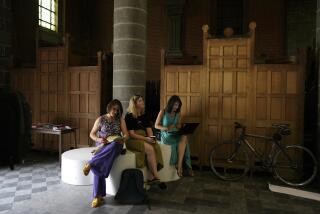Old Paintings Adorn Stone Church’s Ceiling
- Share via
ZILLIS, Switzerland — Not all the famous churches of Europe are as big as a football field, soar high with steeples and flying buttresses and attract hordes of tourists.
In a quiet corner of Switzerland, along a route once traveled by the Romans, stands a stone church with another charm.
It is the one-room sanctuary of St. Martin in this pastoral village south of Chur.
The jewel of the 850-year-old church is an elaborately painted wooden ceiling. In vibrant colors, it tells the story of Jesus on 153 three-foot-square panels.
Each panel is set in a shallow frame, or track, brightly colored with geometric designs. The ceiling has a quilted look.
Depict Jesus Story
The biblical story is 17 panels long and 9 panels wide, with the outermost panels filled with mythological, fish-tailed creatures representing evil, according to Swiss authorities.
The ceiling is set off by a band of geometrical shapes painted along the top of the plastered, white-washed walls.
It is “the oldest late Romanesque piece of this genre in Western Europe to be almost perfectly preserved,” authorities said.
Visitors may follow the story beginning at the left corner of the nave facing the choir. The story zigzags, left to right, to the front entrance. The painting in the middle of the ceiling shows Jesus being tempted by the devil.
Other panels include Jesus bringing clay birds to life, Herod ordering the massacre of the innocents and the wedding feast in Cana.
Patron Saint
The second-to-last rank of nine paintings shows scenes of the life of St. Martin, the church’s patron saint.
A monumental painting of St. Christopher on the outer wall of the front entrance also is noteworthy but has been nearly erased by weather.
In spite of its age, the church stands on even older foundations. Archeologists have uncovered the remains of churches built in the 6th Century and the 9th Century below and next to St. Martin. Roman ruins have also been found on the site.
Like the church, the farming town of Zillis is simple and undisturbed. Only 270 people live in the community, which is set in the peaceful, green Schams Valley. It is part of the canton of Grisons in the far east of Switzerland.
The village gets few tourists, partly because it has no railroad stop. But buses leave regularly from Thusis, the nearest rail stop.
For hundreds of years the Schams Valley was a well-traveled route for prehistoric cultures and for the Romans. The empire builders passed through the area on their way north to the Lake Constance region, where Switzerland, Germany and Austria meet.
Chronicles mention that the Roman Gen. Stilicho passed through in AD 395.
But the route had one drawback. North of Zillis it is cut by the Hinter Rhine River. To cross, ancient travelers ventured into a precipitous, 900-foot-deep gorge. Romans called it the Via Mala, or Bad Road.
Part of the Roman trail remains, etched in the rock. It looks like a goat path. Visitors can still imagine the treacherous crossing, with the river roaring below and rock falling from the sides of the gorge.
Steps Into Gorge
Concrete steps guide visitors into the gorge now. One can walk down to the river, inspect potholes cut by river-spun boulders and feel the spray of a waterfall.
While many tourists drive or take buses to the gorge which, unlike St. Martin’s church, does draw a crowd, hikers can see more of the gorge by following a well-maintained trail from Thusis. The trail continues to Zillis.
The picturesque forest setting follows the river gorge. As it enters the Schams Valley, hikers pass through a covered wooden bridge and get a panoramic view of the valley. The trip, over moderate terrain, takes about two hours.
Thusis is about 30 minutes south by train from Chur, the cantonal capital.
Zillis has only two hotels, the Gasthaus Alte Post, operated by the Schwartz family, and the Pro L’Ava.
A single room at Pro L’Ava costs $30 U.S.; a double, $56. Room rates include continental breakfast. Both hotels are on the main road.
There are more accommodations at Chur, the cantonal capital, and at Thusis, the nearest rail stop. Tourist bureaus will help visitors sort through the choices.
Trains Every 45 Minutes
Trains operate between Chur and Thusis every 45 minutes during the day. Add another 15 minutes for the bus between Thusis and Zillis. Some buses will stop at Via Mala on the way. Check schedules at the bus station across the street from the train stop.
For those without a rail pass, a one-way bus/train ticket from Chur to Zillis costs $11.
For more information on travel in Switzerland, contact the Swiss National Tourist Office, 250 Stockton St., San Francisco 94108, phone (415) 362-2260.
More to Read
Sign up for Essential California
The most important California stories and recommendations in your inbox every morning.
You may occasionally receive promotional content from the Los Angeles Times.













